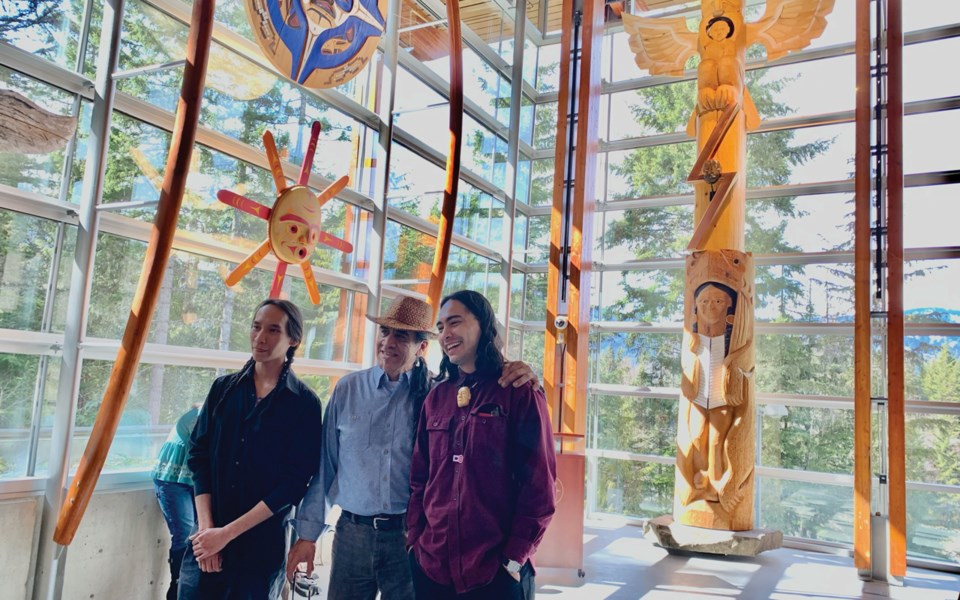When a First Nations story pole is created, it is traditionally awakened by a ceremony where the community comes out to celebrate. On April 22, such a ceremony was to take place at the Squamish Lil’wat Cultural Centre (SLCC) for a story pole designed and created by Salish and Lil’wat carver Ed Archie NoiseCat, with assistance from apprentice Q’áwam’ Redmond Andrews, titled Sqātsza7 Tmicw – Father Land.
However, due to the passing of Lil’wat elder Rosalin Sam, this awakening was postponed. Instead, the ceremony turned into an artist talk where NoiseCat explained to an audience that came from far and wide about the 20-foot-tall art piece that will live in the SLCC for generations to come.
“It is the story of the Thunderbird and the Black Tusk, and how this territory became a shared territory of the great Squamish Nation. Sqātsza7 Tmicw is the story of how a spirit called black crawler brought the women’s warrior song to my auntie Martina during a sweat ceremony,” said NoiseCat.
“It is the bear dancer, a portrait of my cousin Redmond with an eagle fan wearing a bone and a trade bead breastplate. He holds a frog rattle in his right hand and an eagle fan in his left, all of this carved in red and yellow cedar standing on a 900-pound block of basalt.
“The stone represents this land, my father’s land, this territory that is the home of the Peters family from Samahquam and Ts’zil, the home of Nkasusa Chief Harry Peters, my great grandfather, the homeland of my father Ray Peters. Sqātsza7 Tmicw, his fatherland.”
The story pole was crafted over a two-year period out of a mixture of red and yellow cedar that came together with the additions of stone and copper.
The project was jointly funded by the First Peoples Cultural Council, the Whistler Blackcomb Foundation, British Columbia Arts Council and the Province of British Columbia. The event was attended by a variety of people, including some of NoiseCat’s family members, who came all the way from Camin Lake, near 100 Mile House.
The pole consists of two separate cedar trees, a 10-foot red cedar that was gifted to the artist by Pete Peterson, an elder from the Skokomish Nation, and an old growth yellow cedar that came from the RCMP, who had confiscated it from logging poachers.
During the project, NoiseCat took Andrews under his wing as his apprentice, something the young artist was greatly appreciative of.
“This project was pretty well like the first step into my three dimensions. It was super amazing to learn how to use different tools from my cousin here ... That was probably the best summer of my life. So it meant a lot to me,” said Andrews.
“It was the best step to the beginning of my life. I feel it. For those of you that may not know, my father was a carver and I never got to learn a whole lot from him other than just watching, so I had to observe and never actually really got to put a lot of the tools in my hand ... [NoiseCat] teaching me was the best gift I’ve ever gotten.”
Andrews served as the inspiration for the bear dancer “because he’s got such a nice face,” NoiseCat said.
“Plus, he’s an expert on the culture, and he’s going to be here telling people about this for the next 80 years.”
If you wish to view the new story pole, the SLCC is open from Tuesday to Sunday, 10 a.m. to 5 p.m. More information on the exhibit can be found on the SLCC’s website at slcc.ca/ed-noisecat-story-pole.




.jpg;w=80;h=120;mode=crop)